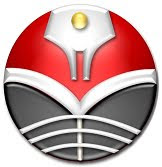CHILDREN’S AND ADOLESCENT LITERATURE
LITERATURE FOR CHILDREN AND ADOLESENCE
ENGLISH LITERATURE 2007 A
CHILDREN’S AND ADOLESCENT LITERATURE
Literature is an art expressed in words. Thus, is not dance, it is not music, it is not a cinematography. It may have elements in common with each of these arts; nevertheless each art has their own identity and special means of expression.
As usual paradigm, literature uses a more complex words, it has to be interpreted beyond. It seems that literature is only intended to adult whose thought can catch the meaning that conveyed in literature.
It can be true, yet actually some of literary works in the world is intended to children. It has no beginning in a traditional sense, that is, we do not know the circumstances leading up to this statement.
Among of the various kinds of literary production, three predominate: fiction, drama and poetry are existed in children’s life. For instances, a nursery rhymes, It seems a poems that intended to children. And of course, there are a bunch of literary works intended to children.
First, Children’s literature deals with the limitation of experiences and understanding of children
Children seldom look back on their childhood, but always forward. Mostly children books or storybook always added by illustrations and pictures by artist because in here the illustration play important role for communicating the mood and the message of the story. the type for children should be large enough for easy reading, space between the lines (leading) should be sufficient to make text clear. Young adult books are focus on developing their skills of reading and deepen understanding of the element of the stories. So that most books or novels for older reader have no illustrations. The using of language in children books is usually everyday language to make it easy to read but this sort of writing does not stretch the reader’s vocabulary or imagination, while older books is usually using wider language.
Second, children’s literature deals with the reflection of children’s life
Everyone figures out that children’s understanding on book or story is different to adult. They understanding are limited to their daily life, what their parents do, the pet do, playing ground, etc. That is why many of children’s books appear these thing obviously to ease children understanding. For instance, in the story of Hiawata (little Indian), the author convey a moral lesson by showing Hiawata’s activities (his daily life).
Third, Children’s literature full of a bunch of imagination
Intended to make children think creatively, an author of children’s book often create a bunch of imagination in their story. For instances, a fairy tale, a fable, etc. it seems a stimulus to encourage children’s thinking yet in the easiest way.
Children are purposed to enjoy and happy while they reading, this is the point that why a lot of children’s book contain of imagination. For example : a Cinderella story, a sleeping beauty, peterpan, and so on.
There were books published as a Children’s books:
1. Fairy Tales – Hans Christian Andersen- 1846 (English)
2. The Blue fairy book –Andrew Lang-
3. The children of the new forest -Frederick Maryatt- 1847
4. Grimm’s Fairy Tales –Jacob and Willhem Grimm- 1823 (English)
5. The jungle book- Ruyard Kipling- 1894
6. Peter Pan – J.M Barrie – 1904-
7. Pinocchio – Carlo Collodi- 1891 (English)
8. Tales of mother goose - Charles Perrault- 1729 (English)
9. Etc
And now let’s concern to adolescence literature which common known as Young-adult literature. The first recognition of young adults as a distinct group was in 1802. The subject matter and the story lines is more complex than children’s literature, they are typically consistent with the age and experience of the main character. The young-adult literature shares the main elements of literature which are character, plot, point of view, setting, theme and style.
Nowadays the classification of adolescences literature/young adult literature is really distinct to children’s literature. The young-adult literature is a fiction, poem, or another pieces of writing that expressed art intended to adult from age 10-21.
Unlike children’s literature, the young adult literature brings more factual events in wide aspects. The theme is also challenging, and the meaning that written in the literary text often appear implicitly.
However, the young adult (adolescence) literature is really important to create a critical thinking for young adult.
And then a books that considered as a young adult book:
1. Harry Potter series –J.K Rowling-
2. Adventures of Huckleberry Finn –Mark Twain- 1884
3. The Adventures of Tom sawyer – Mark Twain-1876
4. A journey to the center of the earth –Jules Verne- 1864
5. Kidnapped –Robert Louis-1886
6. Etc
As explanation above the distinctions between children’s literature and adolescence literature have been flexible and loosely defined. Yet, now we can figure out a little bit boundaries that exist in both. However children’s and adolescence literature is really useful in the term of creating imagination and critical thinking.








